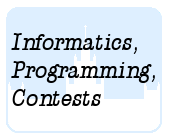Подразделы
Другие разделы
| Тренировка 1 |
| Тренировка 2 |
| Тренировка 4 |
| Тренировка 5 |
Дата и время
04/01/2026 08:25:35
 Тренировка 3
Тренировка 3
A. Average distance B. Bus Pass C. Cutting Banknotes D. Dice Password Security E. Lingo F. Splitting the Loot G. Pachinko H. Hiking I. Ranking J. Stock
 H. Hiking
H. Hiking
 Геометрия
ГеометрияКратчайшие пути из одной вершины
Олимпиадные задачи на английском языке

| 04/02/2008 | Зима 2008 дорешивание (3H) |
| 07/02/2008 | Тренировка (задачи Benelux APC 2007) (H) |
Ограничения: время – 1s/2s, память – 128MiB Ввод: input.txt или стандартный ввод Вывод: output.txt или стандартный вывод 
Послать решение Blockly Посылки Темы Где Обсудить (0)
You have gone on a hiking trip, but now you are getting tired and would like to return
home. As a precaution, you always take your mobile phone with you, so you can call for
help in case of an emergency. However, it only works as long as you stay in range of (one
of) the phone towers in the area. Fortunately, you know precisely where you are and where
you are going, and you brought a map of the area showing the locations of the mobile
phone towers. You want to take the shortest route home, while staying in range of at least
one of those towers.
Input
On the first line an integer `t` `(1\ ≤\ t\ ≤\ 100)`: the number of test cases. Then for each test
case:
One line with two integers `d` `(1\ ≤\ d\ ≤\ 1000)` and `t` `(1\ ≤\ t\ ≤\ 100)`: the maximum
distance to the nearest tower and the number of towers on the map, respectively.
One line containing the starting location.
One line containing the goal location.
`t` lines each containing the location of a tower.
All locations consist of two space-separated integer coordinates `x` and `y` `(1\ ≤\ x,y\ ≤\ 1000)`.
All locations in the input for a single test case will be distinct. The starting locating will
not be more than `d` units away from the nearest tower.
Output
For each testcase:
One line containing the distance to the goal location, or `-1` if the goal location is
unreachable.
Your answer should have an absolute error of at most `10^{-6}`.
Notes
It's OK to be exactly `d` units away from the nearest tower.
The size of the towers is negligible; if you move straight through a tower location,
the tower won't block your path.
Sample Input
1 2 3 1 1 8 2 2 2 4 4 7 3
Sample Output
7.232241

 Начало
Начало